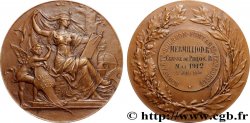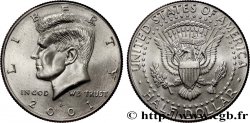fme_957072 - III REPUBLIC Médaille, Centenaire de 1789
10.00 €约 83.70 CNY
数量
加入购物车

种类 Médaille, Centenaire de 1789
日期: 1889
材质 bronze
直径 32,50 mm
模子方针 12 h.
硬币制模工 BARRE Jean-Jacques (1793-1855)
重量 14,55 g.
侧面 lisse
印模 corne BRONZE
关于品相的说明
Restes de rouge de frappe. Présence de quelques rayures
出版目录中的项代码 :
正面
正面的文字 REPUBLIQUE FRANÇAISE À L’EXERGUE BRONZE CORNE / SUFFRAGE UNIVERSEL.
正面的说明书 Tête à gauche de la république portant dans les cheveux un ruban marqué SUFFRAGE UNIVERSEL, signé BARRE .
背面
背面的文字 REPUBLIQUE FRANÇAISE / EXPOSITION UNIVERSELLE // CENTENAIRE / DE / 1789.
背面的说明书 Légende circulaire ; dans une couronne de chêne et d'olivier sous une étoile rayonnante.
评论
Le poinçon se trouve à l’exergue du droit et non sur la tranche.
Les expositions universelles ont été créées pour présenter les réalisations industrielles des différentes nations. Elles représentaient la vitrine technologique et industrielle des participants, témoignant du progrès au cours de la révolution industrielle. La première exposition universelle s'est déroulée à Londres en 1851.
À l'origine, chaque pays disposait d'un espace réservé dans un pavillon central. À partir de 1867, des pavillons nationaux firent leur apparition. En principe, ils étaient attribués seulement s'il y avait des choses à présenter que le pavillon central ne pouvait accueillir. Ils ne tardèrent pas à se généraliser, les nations exposantes construisant des pavillons typiques de l'architecture de leurs pays.
La compétition était omniprésente dans les expositions universelles, et des concours permettaient aux plus méritants d'obtenir des médailles bénéficiant d'un certain prestige.
De nombreuses réalisations architecturales construites à l'occasion d'expositions universelles sont devenues par la suite des symboles des villes qui les ont abritées : la tour Eiffel à Paris, l'Atomium à Bruxelles, le Space Needle à Seattle, la Biosphère à Montréal.
Enfin, la tenue des expositions universelles a toujours été l'occasion de mettre en place des projets d'urbanisme : construction du métro de Paris en 1900 ou celui de Montréal en 1967, extension du métro de Lisbonne en 1998…
Voir http://fr.wikipedia.org/wiki/Exposition_universelle .
The punch is located at the exergue of the right and not on the edge.
World's Fairs were created to showcase the industrial achievements of different nations. They represented the technological and industrial showcase of the participants, testifying to progress during the industrial revolution.. The first World's Fair took place in London in 1851..
Originally, each country had a dedicated space in a central pavilion. From 1867, national pavilions appeared. In principle, they were only allocated if there were things to be presented that the central pavilion could not accommodate.. They soon became widespread, with exhibiting nations building pavilions typical of the architecture of their countries..
Competition was omnipresent at world fairs, and competitions allowed the most deserving to obtain medals that carried a certain prestige..
Many architectural achievements built for world exhibitions have subsequently become symbols of the cities that hosted them: the Eiffel Tower in Paris, the Atomium in Brussels, the Space Needle in Seattle, the Biosphere in Montreal..
Finally, the holding of universal exhibitions has always been an opportunity to implement urban planning projects: construction of the Paris metro in 1900 or that of Montreal in 1967, extension of the Lisbon metro in 1998… See http://fr. Wikipedia. org/wiki/Exposition_universelle
Les expositions universelles ont été créées pour présenter les réalisations industrielles des différentes nations. Elles représentaient la vitrine technologique et industrielle des participants, témoignant du progrès au cours de la révolution industrielle. La première exposition universelle s'est déroulée à Londres en 1851.
À l'origine, chaque pays disposait d'un espace réservé dans un pavillon central. À partir de 1867, des pavillons nationaux firent leur apparition. En principe, ils étaient attribués seulement s'il y avait des choses à présenter que le pavillon central ne pouvait accueillir. Ils ne tardèrent pas à se généraliser, les nations exposantes construisant des pavillons typiques de l'architecture de leurs pays.
La compétition était omniprésente dans les expositions universelles, et des concours permettaient aux plus méritants d'obtenir des médailles bénéficiant d'un certain prestige.
De nombreuses réalisations architecturales construites à l'occasion d'expositions universelles sont devenues par la suite des symboles des villes qui les ont abritées : la tour Eiffel à Paris, l'Atomium à Bruxelles, le Space Needle à Seattle, la Biosphère à Montréal.
Enfin, la tenue des expositions universelles a toujours été l'occasion de mettre en place des projets d'urbanisme : construction du métro de Paris en 1900 ou celui de Montréal en 1967, extension du métro de Lisbonne en 1998…
Voir http://fr.wikipedia.org/wiki/Exposition_universelle .
The punch is located at the exergue of the right and not on the edge.
World's Fairs were created to showcase the industrial achievements of different nations. They represented the technological and industrial showcase of the participants, testifying to progress during the industrial revolution.. The first World's Fair took place in London in 1851..
Originally, each country had a dedicated space in a central pavilion. From 1867, national pavilions appeared. In principle, they were only allocated if there were things to be presented that the central pavilion could not accommodate.. They soon became widespread, with exhibiting nations building pavilions typical of the architecture of their countries..
Competition was omnipresent at world fairs, and competitions allowed the most deserving to obtain medals that carried a certain prestige..
Many architectural achievements built for world exhibitions have subsequently become symbols of the cities that hosted them: the Eiffel Tower in Paris, the Atomium in Brussels, the Space Needle in Seattle, the Biosphere in Montreal..
Finally, the holding of universal exhibitions has always been an opportunity to implement urban planning projects: construction of the Paris metro in 1900 or that of Montreal in 1967, extension of the Lisbon metro in 1998… See http://fr. Wikipedia. org/wiki/Exposition_universelle








 对产品描述纠错
对产品描述纠错 打印
打印 分享我的选择
分享我的选择 提问
提问 Consign / sell
Consign / sell
 产品介绍
产品介绍















